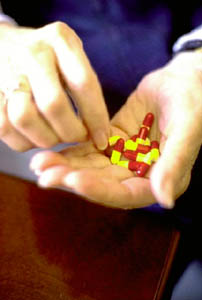![[Metroactive News&Issues]](/gifs/news468.gif)
[ North Bay | Metroactive Central | Archives ]
Industry ads an Rx for trouble
By Chris Lydgate
THEY SOUND like superheroes in some postmodern comic book: Claritin; Propecia; Viagra; Prozac. Like comic-book heroes, they can produce miraculous effects. And like comic-book heroes, they often create as many problems as they solve.
How does an allergy drug (or an anti-impotency pill) become a household name? The answer is as close as your TV screen. The pharmaceutical industry spent an estimated $1.8 billion last year on advertising aimed squarely at consumers, not doctors. These so-called direct-to-consumer, or DTC, marketing efforts have had a "tremendous impact" on prescription drug costs, says Dr. J. Bart McMullan, senior vice president for health services at Regence BlueCross/BlueShield. "It really does affect demand."
DTC marketing has long been a source of frustration for HMOs, but the smoldering resentment burst into flame last month with an article in the Oregon Health Forum, which reported some harsh criticism of drug companies.
Why the palaver? HMO execs say the pharmaceutical marketing machine is the driving force behind a phenomenal surge in prescription-drug costs: most HMOs report that drug expenditures are rising roughly 15 percent per year. "We're just seeing the beginning," says Sheela Andrews, regional director of pharmacy services for PacifiCare Oregon.
To be sure, there are other factors at work, including the proliferation of expensive drugs for previously untreatable conditions, a wave of consolidation among generic drug-makers, and a rising number of patent disputes that have kept cheaper generic drugs out of the marketplace. But there is little doubt that drug-makers' new emphasis on bringing their messages directly to consumers is having far-reaching effects on the business of medicine.
In the past, the question of which drug to prescribe was considered the exclusive domain of the physician. No longer. "Now [patients] are coming in armed and ready for a prescription drug they believe will make their lives better," says Jack Friedman, president of Providence Health Plans.
Because most insurance plans cover prescription drugs, patients are typically insulated from the true cost of their medication. Instead, the tab is picked up by insurance companies, which pass along the cost in their premiums. Providence Health Plans spends more money on prescription drugs than on primary care.
Popular name-brand drugs put doctors in a bind. In many cases, the new drugs represent significant medical advantages. But often there are cheaper alternative or generic medications that might be just as effective. These often go unprescribed, doctors say, because patients prefer the marquee-name drug--especially when they don't have to pay for it.
TAKE A DRUG like Prilosec, a new medication commonly used to treat a painful condition known as gastrointestinal esophageal reflux disorder. "For people with this disorder, this is a godsend," says Dr. Jim Norris, chairman of Kaiser Permanente's Formulary Committee. But thanks to an aggressive marketing campaign by the drug's manufacturer, many patients with mild heartburn or dyspepsia are now asking their doctors for Prilosec (cost: $3 a day) instead of similar, cheaper drugs (cost: 55 cents a day) that would be just as effective in treating their milder conditions.
To combat this crippling inflation, Oregon's HMOs are increasingly shifting the cost to consumers, turning to a solution known as a three-tiered pricing structure. Here's how it works: Patients shell out a sliding co-pay for all their prescriptions. The co-pay is minimal for generic drugs, larger for older, name-brand drugs, and highest for the marquee drugs.
At PacifiCare, for example, the co-pay for Accupril, a brand-name blood-pressure medication, is $28 a bottle. But an older, similar drug, Zestril, is available for $13, and a generic version, Captopril, costs just $8, says Andrews of PacifiCare. (Members have access to several other blood-pressure medications as well, she adds.)
Although graduated co-pays do help to keep costs low, they are not popular with consumers. "You're getting a lot of angry members out there," says Chris Palmedo, public relations manager for PacifiCare, which adopted the new structure in January. "We got a huge influx of calls."
The situation looks as though it will get worse before it gets better. As pharmaceutical companies continue their aggressive marketing efforts, drug costs are projected to outstrip hospital costs in the next decade, which is certain to leave HMO executives feeling down in the dumps.
Maybe they should take a look at some of those cheery antidepressant ads in the glossy magazines.
[ North Bay | Metroactive Central | Archives ]
Copyright © Metro Publishing Inc. Maintained by Boulevards New Media.
![]()
 Bad Medicine
Bad Medicine
From the August 23-29, 2001 issue of the Northern California Bohemian.